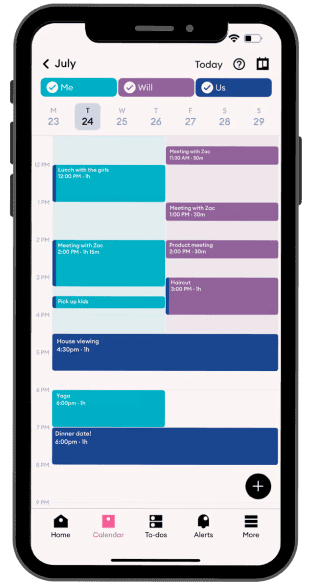Thirty years ago, author Dr Gary Chapman revolutionized the way we think about saying “I love you” with his bestselling book, The Five Love Languages.
In it, he described how everybody has their own way of expressing affection – and how in romantic relationships, those differences in expression can be at the core of miscommunication and missed connections.
While there are five primary Love Languages identified by Dr Chapman, one of the most misunderstood – and maligned – is Receiving Gifts.
Below, we bust some common myths and misconceptions about Receiving Gifts as a love language and show how you can master it and show your partner how much you care in the way they understand best.
Read more: Best couple’s to do list apps – for next level relationships
What are Love Languages?
Love Languages is a framework for couples’ communication invented by Dr. Gary Chapman, counselor, speaker, and author of The Five Love Languages.
It’s based on the idea that people say “I love you” differently.
Some people say it with words, others say it with actions, and others say it – you guessed it – with gifts.
The love languages are:
- Acts of service
- Quality time
- Words of affirmation
- Physical touch
- Receiving gifts
Everyone will have a primary love language; a way of giving and receiving love that comes most naturally to them. It’s the default way they show their partner (and the other loved ones in their lives) that they care about them.
The problem is that two people in a relationship may have different love languages.
Something that’s obviously a means of displaying affection to you may not be so obvious to your partner.
You or your partner may be trying to say “I love you”, but the recipient of said love may not be able to recognise it.
Because you’re speaking Spanish and they only know French!
This can result in missed connections, disappointment, and even resentment.
But if you and your partner can take the time to learn your own love languages and each other’s, you essentially unlock a cheat code for affection. Not only do you know how to say I love you in an impactful way to your partner, but your partner also knows when you’re saying I love you in your own way. You can speak each other’s language, whether that’s “te amo” or “je t’aime”!
How does gift-giving as a love language work?
Gift giving or ‘receiving gifts’ as Dr Chapman calls it is one of the five love languages.
If you or your partner express affection by giving gifts, or feel most loved when receiving a gift, then it might be your or your partner’s primary love language.
First things first
Let’s deal with the elephant in the room straight away.
Receiving gifts is often misunderstood. People look at someone who says that getting stuff is the best way for them to hear I love you, and they immediately call them greedy or materialistic. Nothing could be further from the truth!
Receiving gifts as a love language isn’t really about the thing that’s received.
It’s often more about the fact that the gift giver has taken the time to think about the receiver, figuring out something they’d like or spotting something and thinking of them.
It doesn’t really matter if the gift itself is big or small.
It’s more about the fact that a gift is a tangible expression of love, that they were thought of, and that the gift giver wanted to make them happy.
Gift-giving as a love language works the other way, too.
People who like to receive gifts from their loved ones also often use it to express that love back. They put lots of thought into birthdays & gift-giving holidays, and they’ll often be the person who buys something for someone “just because.”
How to speak the gift-giving love language
If all this sounds very familiar to either you or your partner, then congratulations!
You’ve figured out your love language.
Now, what to do about it?
If gift-giving isn’t something you think you do well at naturally, don’t panic! There are lots of ways you can still be a master gift giver for your partner. Remember, it really is the thought that counts.
Here are a few ideas:
- Send your partner flowers, even if it isn’t a special occasion.
- Buy your partner’s favorite snack food while at the grocery store.
- Get your partner tickets to see their favorite musician or artist.
- Get your partner a gift certificate to a restaurant they want to try.
- Have a coffee or lunch delivered to your partner while at work.
- Leave a small gift for your partner to find behind the coffee machine when they wake up.
Our best tip?
Keep a list of gift ideas, big and small, for your partner. This means that when it comes to an anniversary, birthday, or other gift-giving event, you already have a heap of great ideas ready to go at a moment’s notice.
This also means you don’t have to rely on sudden inspiration for a gift.
Any time your partner says they like something or want something, you can just add it to your list.
Gift-Giving Love Language Examples
The gift-giving love language of one couple is unlikely to be the same as another. This is what can make those first few months of a new relationship a bit challenging. Figuring out the best way to express love to your new partner does require a bit of trial and error.
The idea of sending flowers or coffee is fine, but not so much if your partner has a pollen allergy or dislikes coffee!
Someone whose love language is based around educational events may prefer something like:
- A trip to a museum
- Receiving a book (signed copies are better)
- Going to a lecture about a topic they care about (honestly!)
- Subscription to an academic magazine
Take mental notes about what they like
If you have a partner who thinks a thoughtful gift is getting a book, take note of the kind of books they like and their favorite authors.
Then, do some research.
The thought behind the gift is that you appreciate and care for the side of them who adores academia and study.
Anything you buy for them in this area will be perceived as more meaningful than a box of chocolates or aftershave.
This kind of gift can make them feel accepted in the relationship, too.
And that’s great!
As powerful as gifts get
This is such a potent method that Cupla includes a dedicated To-Do List feature that’s perfect for keeping a secret gift list from your partner.
Use it to start off date night with a bang with just the right kind of flowers, or use it to manage a list of perfect anniversary gift ideas – with anniversary reminders built right into the synced calendar feature, too.
You just can’t lose.
Sounds good? Trial Cupla now for free on iOS and Android.











